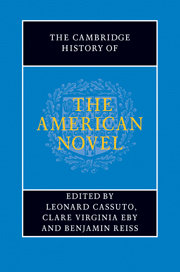Book contents
- Frontmatter
- General Introduction
- PART ONE INVENTING THE AMERICAN NOVEL
- PART TWO REALISM, PROTEST, ACCOMMODATION
- PART THREE MODERNISM AND BEYOND
- Introduction: modernism and beyond
- 37 Stein, Hemingway, and American modernisms
- 38 The Great Gatsby and the 1920s
- 39 Philosophy and the American novel
- 40 Steinbeck and the proletarian novel
- 41 The novel, mass culture, mass media
- 42 Wright, Hurston, and the direction of the African American novel
- 43 Ellison and Baldwin: aesthetics, activism, and the social order
- 44 Religion and the twentieth-century American novel
- 45 Faulkner and the Southern novel
- 46 Law and the American novel
- 47 Twentieth-century publishing and the rise of the paperback
- 48 The novel of crime, mystery, and suspense
- 49 US novels and US wars
- 50 Science fiction
- 51 Female genre fiction in the twentieth century
- 52 Children's novels
- 53 The American novel and the rise of the suburbs
- 54 The Jewish great American novel
- 55 The Beats and the 1960s
- 56 Literary feminisms
- 57 Reimagining genders and sexualities
- PART FOUR CONTEMPORARY FORMATIONS
- A selected bibliography
- Index
38 - The Great Gatsby and the 1920s
from PART THREE - MODERNISM AND BEYOND
Published online by Cambridge University Press: 28 July 2011
- Frontmatter
- General Introduction
- PART ONE INVENTING THE AMERICAN NOVEL
- PART TWO REALISM, PROTEST, ACCOMMODATION
- PART THREE MODERNISM AND BEYOND
- Introduction: modernism and beyond
- 37 Stein, Hemingway, and American modernisms
- 38 The Great Gatsby and the 1920s
- 39 Philosophy and the American novel
- 40 Steinbeck and the proletarian novel
- 41 The novel, mass culture, mass media
- 42 Wright, Hurston, and the direction of the African American novel
- 43 Ellison and Baldwin: aesthetics, activism, and the social order
- 44 Religion and the twentieth-century American novel
- 45 Faulkner and the Southern novel
- 46 Law and the American novel
- 47 Twentieth-century publishing and the rise of the paperback
- 48 The novel of crime, mystery, and suspense
- 49 US novels and US wars
- 50 Science fiction
- 51 Female genre fiction in the twentieth century
- 52 Children's novels
- 53 The American novel and the rise of the suburbs
- 54 The Jewish great American novel
- 55 The Beats and the 1960s
- 56 Literary feminisms
- 57 Reimagining genders and sexualities
- PART FOUR CONTEMPORARY FORMATIONS
- A selected bibliography
- Index
Summary
At a pivotal moment in The Great Gatsby, Nick Carraway traces the genesis of the accelerating tragedy to a kiss that Jay Gatsby bestowed upon Daisy Fay in 1917 as he prepared to depart for the Great War. “One autumn night,” Nick writes, his ostentatious West Egg neighbor – then a lowly infantry lieutenant – suddenly awoke to the ritualistic importance of this most deceptively simple of sensual exchanges: “He knew that when he kissed this girl, and forever wed his unutterable visions to her perishable breath, his mind would never romp again like the mind of God. So he waited, listening for a moment longer to the tuning fork that had been struck upon a star. Then he kissed her. At his lips' touch she blossomed for him like a flower and the incarnation was complete.”
The interlude is the most famous kiss in a corpus that contains so many that a contemporary once congratulated F. Scott Fitzgerald for cataloguing “the osculatory habits of the flapper.” A more generous appraisal would argue that the tableau epitomizes Fitzgerald's talent for dramatizing the poignancy of romance in a gossamer style composed of equal parts enchantment and lachrymosity. And yet, curiously, few critics talk about The Great Gatsby as a love story anymore. While the novel frequently tops polls of great American romances, its popular reputation exists independently of its academic import. When commentators do invoke the word “love,” it tends to follow the prefix “self-” to reaffirm the conventional wisdom that Gatsby's “unutterable visions” have less to do with winning the object of his affection than with selecting her to embody his “platonic conception of himself.”
- Type
- Chapter
- Information
- The Cambridge History of the American Novel , pp. 639 - 652Publisher: Cambridge University PressPrint publication year: 2011



